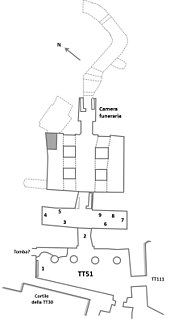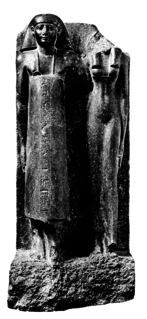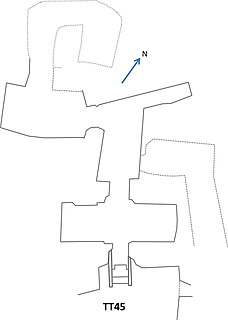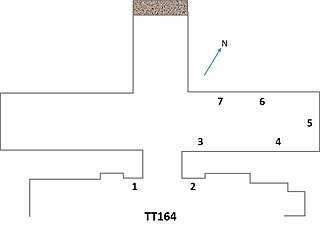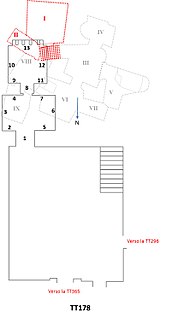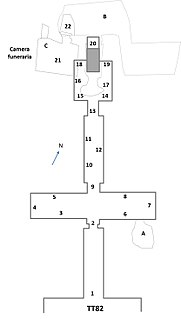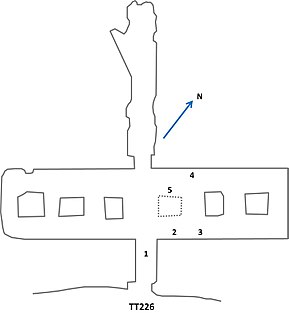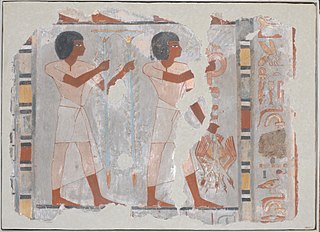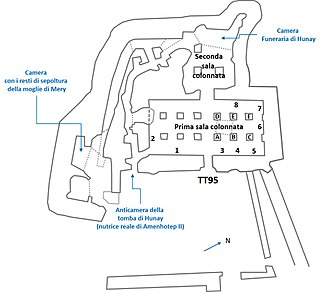| Usermontu Vizier | |
|---|---|
| Dynasty | 18th Dynasty |
| Pharaoh | Tutankhamun to Horemheb |
| Father | Nebmehyt |
| Mother | Raia |
Usermontu was an ancient Egyptian vizier from the reign of Tutankhamun to likely the reign of Horemheb, during the 18th Dynasty.

Ancient Egypt was a civilization of ancient North Africa, concentrated along the lower reaches of the Nile River in the place that is now the country Egypt. Ancient Egyptian civilization followed prehistoric Egypt and coalesced around 3100 BC with the political unification of Upper and Lower Egypt under Menes. The history of ancient Egypt occurred as a series of stable kingdoms, separated by periods of relative instability known as Intermediate Periods: the Old Kingdom of the Early Bronze Age, the Middle Kingdom of the Middle Bronze Age and the New Kingdom of the Late Bronze Age.

The vizier was the highest official in Ancient Egypt to serve the pharaoh (king) during the Old, Middle, and New Kingdoms. Vizier is the generally accepted rendering of ancient Egyptian tjati, tjaty etc., among Egyptologists. The Instruction of Rekhmire, a New Kingdom text, defines many of the duties of the tjaty, and lays down codes of behavior. The viziers were often appointed by the pharaoh. During the 4th Dynasty and early 5th Dynasty, viziers were exclusively drawn from the royal family; from the period around the reign of Neferirkare Kakai onwards, they were chosen according to loyalty and talent or inherited the position from their fathers.

Tutankhamun was an Egyptian pharaoh of the 18th dynasty, during the period of Egyptian history known as the New Kingdom or sometimes the New Empire Period. He has, since the discovery of his intact tomb, been referred to colloquially as King Tut. His original name, Tutankhaten, means "Living Image of Aten", while Tutankhamun means "Living Image of Amun". In hieroglyphs, the name Tutankhamun was typically written Amen-tut-ankh, because of a scribal custom that placed a divine name at the beginning of a phrase to show appropriate reverence. He is possibly also the Nibhurrereya of the Amarna letters, and likely the 18th dynasty king Rathotis who, according to Manetho, an ancient historian, had reigned for nine years—a figure that conforms with Flavius Josephus's version of Manetho's Epitome.
Usermontu is depicted in the tomb of Khonsu, called To (TT 31). In the hall Usermontu and his brother Huy, who was a prophet of Montu are shown offering to the barque of Montu. Usermontu is said to be born of Maia. [1] [2] A statue from a private collection gives the name of his father as Nebmehyt. [3] [4]
Montu was a falcon-god of war in ancient Egyptian religion, an embodiment of the conquering vitality of the Pharaoh. He was particularly worshipped in Upper Egypt and in the district of Thebes, despite being a Delta-native, astral deity.
[Ramesses II] whom victory was foretold as he came from the womb,
Whom valor was given while in the egg,
Bull firm of heart as he treads the arena,
Godly king going forth like Montu on victory day.
A second individual by the name of Usermontu is mentioned in the tomb, but this individual is the son of Khonsu. This younger Usermontu is a High Priest of Sobek.
Sobek, in Greek, Suchos (Σοῦχος) and from Latin Suchus, was an ancient Egyptian deity with a complex and fluid nature. He is associated with the Nile crocodile or the West African crocodile and is represented either in its form or as a human with a crocodile head. Sobek was also associated with pharaonic power, fertility, and military prowess, but served additionally as a protective deity with apotropaic qualities, invoked particularly for protection against the dangers presented by the Nile.
The vizier Usermontu is also depicted in the tomb of the High Priest of Sobek, Hatiay (TT 324). Usermontu is shown seated at a banquet with vizier Nebamun(?). [5]
A stela of Usermontu was found in Armant. The text includes a hymn to Montu. [6]
